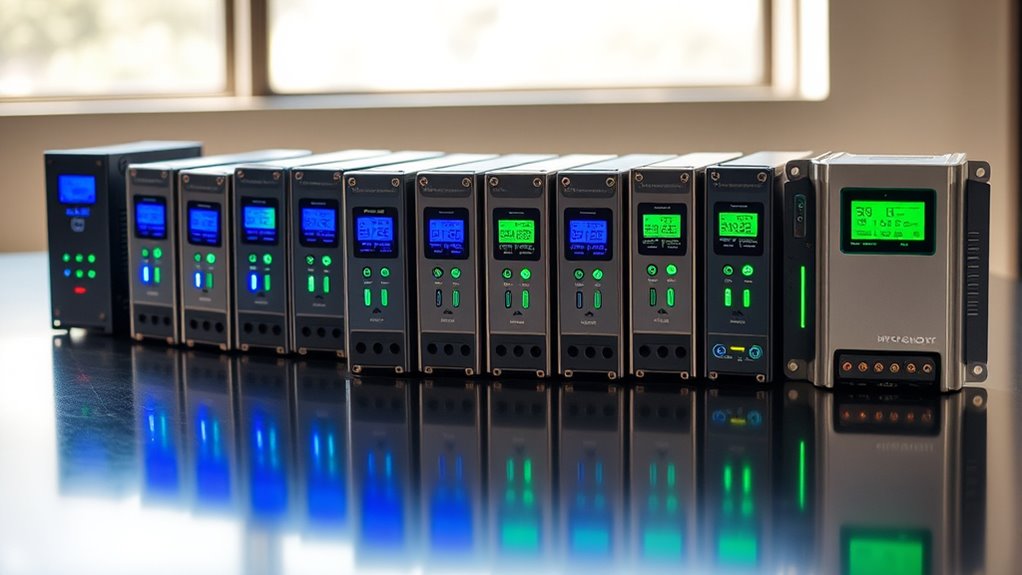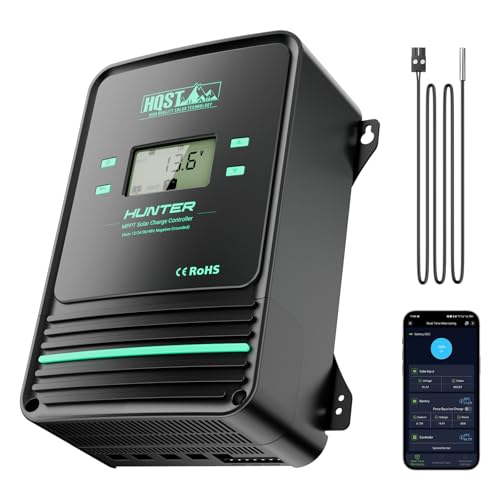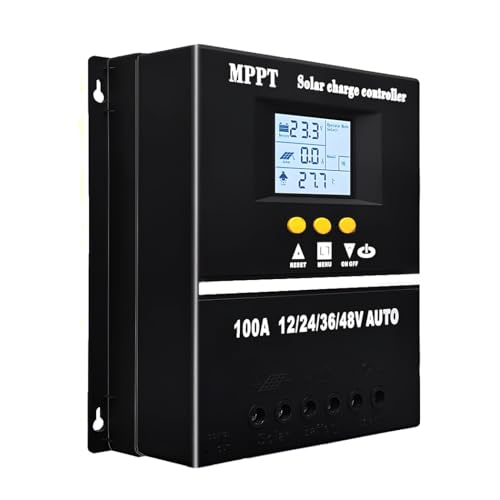If you’re looking for the best MPPT solar charge controllers for 60–100A power solutions, I recommend models like LiTime Bluetooth controllers, POWLAND 100A and 120A units, and HQST 100A controllers, which offer high efficiency, multiple system voltage support, LCD displays, and USB ports. These controllers provide reliable performance for large off-grid or residential setups, ensuring maximum energy harvest and safety. Keep exploring further to discover detailed features and how to choose the right one for your needs.
Key Takeaways
- Focus on controllers supporting 60–100A charging currents with MPPT efficiency ≥99% for maximum power output.
- Prioritize models compatible with system voltages from 12V to 48V and PV input up to 160V for flexible array configurations.
- Look for features like Bluetooth app control, real-time LCD monitoring, and remote management capabilities.
- Ensure robust protections including overcurrent, reverse polarity, and temperature safeguards for system safety.
- Consider units that support multiple battery chemistries and scalability options for larger, expandable solar setups.
LiTime MPPT Solar Charge Controller (Bluetooth) for Solar System
If you’re looking for a reliable MPPT solar charge controller that offers smart monitoring and high efficiency, the LiTime Bluetooth-enabled model is an excellent choice. It supports 12/24/36/48V systems with a 150V max voltage and 100A current capacity, compatible with LiFePO4 and Lead-Acid batteries. Its 99% MPPT tracking efficiency converts 30% more sunlight than PWM controllers, even in low light. The LCD display shows real-time data, while Bluetooth allows remote monitoring within a 50ft range. With a robust aluminum heat sink, quiet operation, and a 3-year warranty, it’s perfect for residential or off-grid solar setups.
Best For: homeowners and off-grid enthusiasts seeking a high-efficiency, Bluetooth-enabled MPPT solar charge controller for residential or small-scale solar systems.
Pros:
- 99% MPPT tracking efficiency for maximum power harvest even in low-light conditions
- Bluetooth connectivity with app support for remote system monitoring up to 50ft in open space
- Robust die-cast aluminum heat sink and quiet operation with optional silent mode for extended device lifespan
Cons:
- Not waterproof, unsuitable for marine environments like boats or yachts
- Maximum PV input limits (e.g., 12V@1500W, 24V@3000W) require careful system sizing to prevent overload
- Limited range through walls or metal barriers, potentially restricting remote access in certain installations
100A MPPT Solar Charge Controller with USB and LCD Display
A MPPT solar charge controller with USB and LCD display is an excellent choice for users who want real-time monitoring and convenient charging options. This 100A model supports 12V and 24V systems with automatic voltage adaptation, making it versatile for various setups. Its upgraded MPPT technology delivers up to 99% efficiency, maximizing solar energy use. The LCD screen provides instant system status and adjustable parameters, including timer-based ON/OFF modes. Safety features like overcurrent, short circuit, and low voltage protection safeguard your batteries. Plus, the USB port allows easy device charging, making this controller ideal for both home and industrial applications.
Best For: users seeking a high-capacity, efficient solar charge controller with real-time monitoring, versatile voltage support, and convenient device charging options for residential, industrial, or commercial solar systems.
Pros:
- High tracking efficiency up to 99% maximizes solar energy utilization
- LCD display offers real-time system status and customizable settings
- Supports multiple safety features including overcurrent, short-circuit, and low voltage protections
Cons:
- May require technical knowledge for optimal setup and parameter adjustments
- Larger size and weight due to high capacity design might need ample mounting space
- Price point could be higher compared to lower-capacity or simpler controllers
POWLAND 100A MPPT Solar Charge Controller
The POWLAND 100A MPPT Solar Charge Controller stands out for its high current capacity and advanced tracking technology, making it ideal for larger solar setups such as RVs and home systems. It supports 12V, 24V, 36V, and 48V systems, automatically detects voltage, and is compatible with various lead-acid and lithium-ion batteries. Its 4-level charging algorithm ensures fast, safe, and efficient charging. With MPPT technology, it achieves a photovoltaic utilization rate of ≥99% and efficiency of ≥98.1%. Multiple protections, an easy-to-read LCD, and robust construction make it reliable and user-friendly for demanding applications.
Best For: users with large-scale solar setups such as RVs or household systems seeking high efficiency and reliable battery management.
Pros:
- Supports a wide range of system voltages (12V, 24V, 36V, 48V) for versatile applications
- High photovoltaic utilization rate (≥99%) and efficiency (≥98.1%) ensure maximum energy harvesting
- Multiple protections (short circuit, reverse polarity, overload) enhance safety and system longevity
Cons:
- May be more expensive compared to lower-capacity controllers
- Requires proper installation and understanding of MPPT technology for optimal use
- Large size and high current capacity might be overkill for small or simple solar systems
MPPT Solar Charge Controller 100A (12V/24V) with LCD Display
For those seeking a reliable and efficient solar charge controller for their off-grid or mobile power setups, the MPPT Solar Charge Controller 100A (12V/24V) with LCD Display is an excellent choice. It supports auto-detection of 12V or 24V systems, works with various battery types like LiFePO4, AGM, Gel, and Flooded, and handles solar panel inputs up to 160V. With advanced MPPT technology, it achieves up to 99% effectiveness by automatically adjusting voltage for ideal power harvesting. The built-in LCD provides real-time monitoring of charging status, battery voltage, and system faults, while dual USB ports add convenient device charging.
Best For: outdoor enthusiasts, RV owners, and off-grid solar system users seeking a high-efficiency, reliable charge controller with versatile battery compatibility and real-time monitoring.
Pros:
- Supports auto-detection of 12V/24V systems and multiple battery types including LiFePO4, AGM, Gel, and Flooded.
- Up to 99% MPPT efficiency for optimal solar power harvesting and flexible input voltage up to 160V.
- Built-in LCD display with real-time system monitoring and dual USB ports for charging mobile devices.
Cons:
- Customer ratings are moderate at 4.1 out of 5 stars based on 64 reviews.
- Slightly larger size and weight compared to simpler controllers, which may be a consideration for compact setups.
- Requires sign-in to submit feedback on pricing or report lower prices elsewhere.
MPPT Solar Charge Controller with LCD Display and USB
Among the top features to contemplate, an MPPT solar charge controller with an LCD display and USB port stands out as a game-changer for users seeking real-time monitoring and easy device connectivity. This controller offers seven operation modes, including charging, light control, and manual settings, all visible on a large LCD screen. It automatically tracks the maximum power point, ensuring peak energy transfer from panels to batteries. The USB port provides convenient charging for devices directly from your solar setup. Compatible with 12V to 48V systems and supporting lead-acid or lithium batteries, it combines efficiency, flexibility, and user-friendly features for versatile solar management.
Best For: homeowners, solar enthusiasts, and small-scale energy users seeking efficient, versatile solar charge management with real-time monitoring and device connectivity.
Pros:
- Offers seven operation modes for flexible system control and customization
- Equipped with a large LCD display for real-time monitoring of system parameters
- Supports USB charging, providing convenient device power directly from the solar setup
Cons:
- Customer reviews indicate an average rating of 3.7 stars, suggesting potential areas for improvement
- Compatibility and installation may require some technical knowledge for optimal setup
- Limited information on advanced features or integrations beyond basic operation modes
100A MPPT Solar Charge Controller with LCD Display
A MPPT solar charge controller with an LCD display is ideal for users who want real-time system monitoring and easy control over their solar setup. I find these controllers invaluable because they provide instant data on voltage, current, power, and system status through the LCD screen, making troubleshooting and adjustments straightforward. With protections like overcurrent, short circuit, reverse polarity, and temperature compensation, they ensure safe and reliable operation. The LCD interface simplifies management, letting me fine-tune parameters and monitor performance without complex software. Overall, this integration of advanced MPPT technology and user-friendly display enhances efficiency and peace of mind in managing your solar power system.
Best For: homeowners, outdoor enthusiasts, or off-grid system users seeking reliable, real-time monitoring and safe, efficient solar power management.
Pros:
- High tracking efficiency up to 99% with MPPT technology increases energy harvest by 20%-40%.
- User-friendly LCD display provides instant access to voltage, current, power, and system status for easy troubleshooting and adjustments.
- Comprehensive safety protections including overcurrent, short circuit, reverse polarity, and temperature compensation ensure reliable operation and device longevity.
Cons:
- The device’s size and weight may be less convenient for very compact or portable setups.
- Limited to 12V/24V systems, which may not suit larger or more complex solar configurations.
- Customer ratings are moderate, indicating potential variability in user experience and support.
PowMr 100A MPPT Solar Controller with LCD Display
The PowMr 100A MPPT Solar Controller with LCD Display stands out as an excellent choice for large-scale solar setups that demand high capacity and reliable performance. It allows parallel connection of up to 12 units, boosting system capacity and enhancing stability, with compatibility for an 80A model for further expansion. Its die-cast aluminum construction ensures efficient heat dissipation, while the upgraded turbofan fan keeps noise levels low. Supporting various battery types and voltages, it offers customizable settings and advanced protections. With MPPT technology reaching at least 99% efficiency and peak conversion up to 97%, this controller delivers dependable, high-performance power management for demanding solar applications.
Best For: large-scale solar installations requiring high capacity, reliable performance, and flexible system expansion for RVs, boats, yachts, or commercial setups.
Pros:
- Supports up to 12 units in parallel, significantly boosting system capacity and reliability.
- Equipped with advanced MPPT technology achieving at least 99% tracking efficiency and peak conversion efficiency up to 97%.
- Durable die-cast aluminum construction with an upgraded turbofan fan for efficient, quiet cooling.
Cons:
- Requires careful setup, including PV input disconnection before parameter adjustments.
- May be complex for beginners due to multiple configurable settings and system expansion options.
- External temperature probes are necessary for optimal battery temperature monitoring, adding to installation complexity.
SUNYIMA 100A MPPT Solar Charge Controller with LCD Display
If you’re looking for a reliable MPPT solar charge controller that combines high performance with ease of monitoring, the SUNYIMA 100A model is an excellent choice. It features an intuitive LCD display, dual USB ports, and multiple load control modes. With advanced MPPT technology, it achieves up to 99% tracking efficiency, ensuring maximum power extraction from your panels. The controller supports 12V/24V systems and uses a high-precision master chip for real-time monitoring of charging and discharging currents. Its built-in protections—overvoltage, short circuit, overload, overcharge, and over-discharge—make it safe and dependable for various solar setups.
Best For: homeowners, solar enthusiasts, and small to medium solar system users seeking reliable, efficient, and easy-to-monitor MPPT solar charge control.
Pros:
- High tracking efficiency of up to 99% maximizes solar energy utilization.
- Intuitive LCD display provides real-time monitoring of charging and discharging currents.
- Supports multiple load control modes and built-in safety protections for reliable operation.
Cons:
- Requires careful wiring sequence; connecting batteries before panels is essential to avoid issues.
- May need technical knowledge for initial setup, especially for system voltage detection.
- Limited to 12V/24V systems, which may not suit larger or more complex setups.
100A MPPT Solar Charge Controller with LCD Display and Dual USB
For those seeking a reliable solar charge controller that combines advanced MPPT technology with user-friendly features, the 100A model with LCD display and dual USB ports stands out. It offers up to 99.5% efficiency, automatically recognizing 12V to 48V systems, and quickly tracks the maximum power point of your panels. The multi-function LCD backlight shows real-time data like battery voltage, charging currents, and temperature, while the dual USB ports enable easy device charging. Compatible with various batteries, it provides extensive protections against over-voltage, over-current, and overheating. Its versatile modes and straightforward startup make it ideal for reliable, efficient energy management.
Best For: DIY solar enthusiasts and off-grid users seeking a high-efficiency, versatile charge controller with comprehensive protections and user-friendly features.
Pros:
- High efficiency of up to 99.5% with advanced MPPT technology for optimal energy utilization
- Multi-function LCD display showing real-time operational data and versatile control modes
- Dual USB ports for convenient charging of devices and compatibility with various battery types
Cons:
- May not fully implement MPPT functionality due to the integration of both MPPT and PWM technologies
- Requires correct startup procedure (connect batteries first) for proper operation
- Slightly complex setup for beginners unfamiliar with solar charge controllers
MPPT 100A 12V/24V Solar Charge Controller with LCD Display
A standout choice for those seeking reliable, high-capacity solar management is the MPPT 100A 12V/24V Solar Charge Controller with LCD Display. This controller supports both 12V and 24V systems, with a max input voltage of 100V and a capacity to handle up to 1300W for 12V and 2600W for 24V setups. Its blacklight LCD display offers clear system monitoring, while compatibility with lead-acid and Lithium batteries ensures versatility. Built-in protections guard against overcharge, overdischarge, overload, and more, making it a safe, efficient solution for large-scale solar projects. Plus, professional support guarantees peace of mind.
Best For: homeowners, solar enthusiasts, or small to large-scale solar installations seeking reliable, high-capacity MPPT charge control with versatile battery compatibility and comprehensive safety features.
Pros:
- Supports both 12V and 24V systems with high input voltage capacity up to 100V.
- Compatible with multiple battery types including lead-acid and Lithium (LiFePO4), offering versatile application options.
- Equipped with a clear LCD display and multiple protections for safe, efficient operation.
Cons:
- May require technical knowledge for optimal installation and configuration.
- Larger capacity and advanced features could lead to a higher initial cost.
- Limited to a maximum input voltage of 100V, which may restrict some high-voltage solar panel setups.
PowMr 100A MPPT Solar Charge Controller
The PowMr 100A MPPT Solar Charge Controller stands out for its impressive parallel functionality, supporting up to 12 units simultaneously. This allows me to expand my solar system easily, increasing both power output and energy storage. It supports 12V, 24V, 36V, and 48V systems with PV input up to 160V, making it versatile for various setups. Its multi-stage charging—Bulk, Boost, and Float—maximizes battery lifespan while ensuring efficient energy harvesting with up to 99% tracking efficiency. Safety features like over-current, short-circuit, and polarity protections give me confidence in reliable, safe operation for large-scale solar projects.
Best For: those seeking a highly scalable and efficient solar charge controller capable of supporting large-scale solar energy systems with multiple units and diverse battery types.
Pros:
- Supports up to 12 units in parallel for easy system expansion.
- High PV input voltage up to 160V with excellent MPPT tracking efficiency of 99%.
- Compatible with various battery chemistries, including lithium and user-defined options.
Cons:
- May require complex installation and configuration for large, multi-unit setups.
- Higher initial cost compared to smaller or less feature-rich controllers.
- Potential for increased maintenance with multiple units in parallel.
Upgraded 100A MPPT Solar Charge Controller (12V-48V, LCD, Dual USB)
If you’re seeking reliable and efficient solar charge management, the Upgraded 100A MPPT Solar Charge Controller stands out with its advanced technology and user-friendly features. It boasts high-efficiency MPPT tracking, achieving at least 99.5%, and recognizes 12V to 48V systems, supporting various battery types like lead-acid and lithium. The LCD display provides real-time data on voltage, current, temperature, and mode, while dual USB ports offer convenient device charging. With multiple safety protections against over-voltage, over-current, and overheating, plus flexible operating modes and a reset feature, this controller ensures peak performance and ease of use for your solar setup.
Best For: DIY solar enthusiasts and users seeking a high-capacity, efficient, and versatile solar charge controller for 12V to 48V systems with real-time monitoring and safety features.
Pros:
- High MPPT efficiency of at least 99.5% for optimal energy harvest
- Supports multiple battery types including lead-acid and lithium, with flexible operating modes
- User-friendly LCD display with real-time system data and dual USB charging ports
Cons:
- May not fully utilize MPPT capabilities in all scenarios due to integration with PWM technology
- Requires initial connection to a powered battery before connecting solar panels for proper startup
- Limited to a 1-year warranty, which might be short for some long-term applications
HQST 100A MPPT Solar Charge Controller
Looking for a reliable MPPT solar charge controller that can handle large-scale energy setups? The HQST 100A MPPT Controller fits the bill perfectly. It features Bluetooth app control and an LCD display, making monitoring and adjustments straightforward. Compatible with various battery types and voltages, including LiFePO4, AGM, and flooded batteries, it offers high efficiency with up to 99% tracking and 98.7% conversion rates. Its parallel charging support allows connecting up to nine controllers for bigger systems. Active cooling with dual fans and multiple safety protections ensure durability. Overall, it’s a robust, versatile choice for demanding solar power applications.
Best For: individuals or businesses seeking a high-capacity, versatile MPPT solar charge controller capable of managing large-scale and complex solar energy systems with advanced monitoring and safety features.
Pros:
- High-efficiency MPPT technology with up to 99% tracking and 98.7% conversion rate, maximizing solar energy transfer
- Supports multiple battery types and voltages, including LiFePO4, AGM, flooded, and customized options
- Bluetooth app control and LCD display for real-time monitoring, data logging, and manual adjustments
Cons:
- Requires cables (not included) for parallel controller setup, adding to initial setup complexity
- Bluetooth connectivity limited to 10 meters (33 feet), which may restrict remote monitoring
- Active cooling fans operate only above 113℉, potentially affecting performance in extremely hot environments
100A MPPT Solar Charge Controller with LCD Display and Dual USB
For those seeking convenience and real-time monitoring, a MPPT solar charge controller with an LCD display and dual USB ports offers essential features that simplify system management. This controller employs advanced MPPT technology, automatically recognizing 12V to 48V systems and achieving up to 99.5% efficiency, maximizing energy harvest. The backlit LCD displays real-time data like battery voltage, charging current, temperature, and system status, making it easy to track performance. With seven operating modes, including timing and manual control, plus extensive safety protections, it ensures reliable, flexible operation. Dual USB ports provide convenient device charging, enhancing overall system usability and user experience.
Best For: DIY solar enthusiasts, off-grid homeowners, and users seeking real-time system monitoring and versatile control options for their solar setups.
Pros:
- High efficiency with advanced MPPT technology achieving up to 99.5% energy harvest
- Clear backlit LCD display for real-time data and system status monitoring
- Multiple operating modes and extensive safety protections for reliable, flexible operation
Cons:
- Combines MPPT and PWM technologies, which may not provide full true MPPT performance in all conditions
- Slightly complex setup for beginners due to multiple operating modes and features
- Limited to 100A capacity, which may not suit larger or more complex solar systems
POWLAND 120A MPPT Solar Charge Controller
The POWLAND 120A MPPT Solar Charge Controller stands out as an ideal choice for large-scale solar setups, thanks to its impressive 120A maximum charging current and universal voltage support. It seamlessly adapts to 12V–96V systems, making it versatile for various applications like RVs, off-grid homes, and mobile power stations. Its industry-leading 98% MPPT efficiency maximizes energy harvest, extracting up to 30% more power than PWM controllers. Supporting multiple battery types and featuring intelligent three-stage charging, it extends battery life notably. The high-resolution LCD provides real-time system data, and built-in protections ensure safety and reliability in demanding environments.
Best For: large-scale solar systems, RV owners, off-grid home setups, and mobile power stations seeking high-capacity, efficient energy management.
Pros:
- Industry-leading 98% MPPT efficiency maximizes solar energy harvest.
- Supports multiple battery types with intelligent three-stage charging for extended battery life.
- Universal voltage support (12V–96V) compatible with diverse solar configurations.
Cons:
- May be complex to install for beginners without technical knowledge.
- Higher cost compared to simpler PWM controllers.
- Requires proper wiring and protection measures to ensure safety and optimal operation.
Factors to Consider When Choosing MPPT Solar Charge Controllers 60–100a

When selecting an MPPT solar charge controller in the 60–100a range, I pay close attention to compatibility with my batteries and the maximum input voltage it can handle. I also consider how efficient it is at charging and what protection features are included to guarantee safety and longevity. Additionally, I look for clear display and monitoring tools to keep track of system performance easily.
Compatibility With Batteries
Choosing an MPPT solar charge controller with the right battery compatibility is essential for maintaining battery health and ensuring peak system performance. First, you need to verify that the controller supports your specific battery type, whether it’s LiFePO4, Gel, AGM, Flooded, or Lithium-ion, to optimize charging and avoid damage. It’s also important to confirm the controller matches your battery system voltage, such as 12V, 24V, 36V, or 48V, ensuring proper system integration. Additionally, check that the maximum charging current aligns with your battery bank’s capacity to prevent overcurrent issues. finally, make sure the controller offers features like low-voltage cutoff and appropriate charging algorithms suited to your battery chemistry, which help prolong battery life and guarantee safe operation.
Maximum Input Voltage
Selecting an MPPT solar charge controller with the right maximum input voltage guarantees your system operates safely and efficiently. This parameter defines the highest voltage the controller can handle from your panels without risking damage. It’s vital to match the controller’s maximum input voltage with your solar array’s open-circuit voltage (Voc), especially in cold weather, when Voc can rise considerably. Exceeding this limit can lead to system faults, shutdowns, or even permanent damage. Controllers with higher maximum input voltages give you more flexibility to expand or connect panels in series, maximizing your system’s capacity. To guarantee safe operation, always verify that your panel array’s Voc stays below the controller’s maximum input voltage under all conditions, avoiding costly issues down the line.
Charging Efficiency Levels
Higher charging efficiency in MPPT solar charge controllers means more of the solar energy captured gets stored in your batteries, which is essential for maximizing system performance. These controllers can reach efficiency levels of up to 99%, ensuring minimal energy loss during conversion. When efficiency is high, more power from your panels is effectively transferred, leading to faster battery charging and better overall system output. Environmental factors like temperature, shading, and the voltage difference between panels and batteries can influence efficiency, but advanced MPPT technology constantly tracks the maximum power point to optimize performance. Choosing a controller with superior efficiency means you’ll get the most from your solar setup, especially during varied sunlight conditions, ensuring your batteries are charged quickly and reliably.
Protection Features Included
Protection features are critical components to look for in MPPT solar charge controllers rated between 60 and 100 amps, as they safeguard your system against various electrical faults. Overcurrent, short-circuit, reverse polarity, and overvoltage protections prevent damage to both the controller and batteries, ensuring system longevity. Low-voltage and over-discharge safeguards help maintain battery health by disconnecting loads or halting charging when voltage limits are reached. Temperature compensation and thermal protection keep the controller operating safely in different environments, avoiding overheating or freezing issues. Lightning and surge protection features shield your system from power surges caused by thunderstorms or electrical faults. Additionally, integrated fault alarms and system status indicators provide real-time alerts, allowing me to respond quickly and prevent potential failures.
Display and Monitoring Tools
A key factor when choosing MPPT solar charge controllers with a 60–100 amp rating is the quality of their display and monitoring tools. A good controller should have an LCD screen that shows real-time system voltage, current, and power output, making it easy to keep tabs on performance. Bluetooth or app connectivity adds flexibility, allowing me to monitor system status remotely from my phone or computer. Multiple indicators for load and system status help quickly identify faults, overcharging, or discharging issues. Some controllers even store detailed historical data, like 300 days of usage logs, to analyze long-term trends. An intuitive, clear interface with a backlit screen and simple menu navigation enhances the overall user experience, ensuring easy management of my solar system.
Expansion Capabilities
When expanding a solar system with MPPT charge controllers rated between 60 and 100 amps, it’s vital to verify the controllers support parallel connections and system scaling. Many controllers in this range are designed to be linked together, increasing overall capacity by adding more units. To do this effectively, ensure the controllers have compatible communication ports and are built for parallel operation, which helps maintain stable, synchronized performance. It’s also important to check the maximum number of units supported and the total current load they can handle safely. Proper system expansion requires matching voltage settings and communication protocols across all controllers to ensure reliable operation and prevent issues down the line. Verifying these capabilities will save you time and improve system scalability.
Operating Environment Tolerance
Choosing the right MPPT solar charge controller for your setup requires careful attention to its operating environment tolerance. I look for a controller with an temperature range that matches my installation site, typically from -10°C to 60°C, to prevent overheating or freezing issues. Adequate thermal management, such as heat sinks or cooling fans, is essential for maintaining efficiency in hot conditions. I also check the protection ratings, like IP or NEMA, especially if there’s exposure to dust, moisture, or outdoor elements, even if it’s not fully waterproof. The controller must operate reliably in extreme environments, including high humidity or corrosive atmospheres. Ultimately, I ensure its voltage and current tolerances can handle environmental fluctuations, ensuring stable performance regardless of weather or sunlight variations.
Ease of Installation
Ease of installation is a critical factor to contemplate because it can markedly impact the time and effort needed to set up your MPPT solar charge controller. I recommend choosing models with clear wiring diagrams and user-friendly connection terminals, which simplify the process and reduce errors. Opt for controllers with plug-and-play features or quick-connect cables to save time and effort during installation. Ensuring the controller supports automatic system voltage detection is also beneficial, as it eliminates manual configuration mistakes. Additionally, look for units with extensive, easy-to-understand manuals and setup guides to make the process straightforward. Finally, consider controllers with integrated mounting brackets or compact designs, especially if space is limited, to facilitate secure and hassle-free installation.
Frequently Asked Questions
What Maintenance Is Required for MPPT Solar Charge Controllers?
I check my MPPT solar charge controller regularly to make sure it’s clean and free of dust or debris. I also inspect the wiring for corrosion or loose connections and verify that the display shows proper voltage and current readings. Additionally, I update the firmware if updates are available and keep an eye on any error messages. Proper maintenance keeps my system running efficiently and extends its lifespan.
How Do Temperature Variations Affect MPPT Efficiency?
Did you know that temperature swings can reduce MPPT efficiency by up to 25%? I’ve seen this happen firsthand; as temperatures rise, the controller’s ability to optimize power drops. Cooler temps improve performance because the internal components operate more effectively. So, I always recommend installing controllers in shaded areas or adding ventilation to keep temperatures stable, ensuring your system runs smoothly and maximizes energy capture, no matter the weather.
Can MPPT Controllers Handle Fluctuating Grid Inputs?
Yes, MPPT controllers can handle fluctuating grid inputs quite well. I’ve seen them adapt quickly to voltage and current changes, optimizing power transfer efficiently. They monitor input fluctuations constantly and adjust their operation to maximize energy harvest without risking damage. So, if your grid input varies, rest assured, a good MPPT controller will manage those fluctuations smoothly, ensuring your system stays stable and performs at its best.
What Are Common Troubleshooting Steps for MPPT Failures?
Think of troubleshooting an MPPT controller like untangling a knot—you gotta start simple. First, I check all connections for corrosion or looseness. Then, I verify the settings match my system’s voltage and current specs. I also scan for firmware updates or error codes. If issues persist, I test the panel voltages and ensure the controller isn’t overheating. These steps usually clarify up most problems efficiently.
How Do I Upgrade or Expand My Existing MPPT System?
To upgrade or expand my MPPT system, I start by evaluating my current setup’s capacity and compatibility. I then choose a higher-rated controller or additional units that match my panels and battery bank. I make certain wiring and connectors are suitable for the increased load. Finally, I carefully install and configure the new components, testing the system thoroughly to maximize efficiency and safety.
Conclusion
Choosing the right MPPT solar charge controller is like finding the perfect puzzle piece; it completes your solar setup seamlessly. I once overlooked a controller’s features, only to face system inefficiencies—lesson learned. With over 15 top options in 2025, you’ll find one that fits your needs perfectly. Remember, investing in quality now saves you time and money later, much like planting a sturdy tree that grows stronger every year.

























